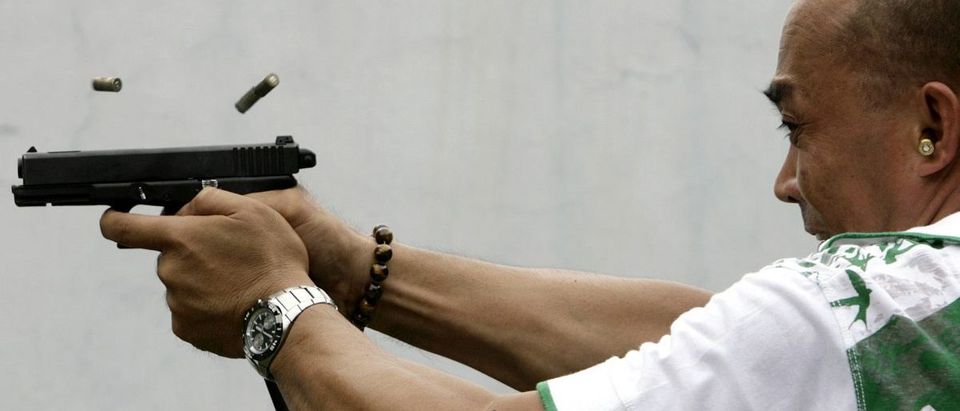By Mike Ox
I’m going to let you in on a little firearms training secret today.
It’s a trick used by instructors to get shooters on target quickly when they’re having problems, but don’t have the time to work with every shooter on the line as much as they’d like.
Roughly half of the shooters I work with keep using this trick for the rest of their lives.
The problem is this technique that works so well shooting paper is almost guaranteed to fail in a life and death shooting situation.
What is it?
It’s closing one eye while shooting.
This will cause an immediate improvement in accuracy for about half of all shooters.
But it creates big challenges down the road if they ever end up needing to shoot under stress.
You see, under stress, it’s very hard to close one eye.
First, the brain wants both eyes open so it can detect threats better, in a wider field of view. There’s a paradox here with the fact that people tend to have tunnel vision under stress, but there’s an even bigger reason than peripheral vision at play.
The second reason is the biggest. The brain processes visual images roughly 20-30% quicker with both eyes open than with one eye closed. In a fight for your life, seeing 20-30% quicker is H U G E.
Here’s the problem with shooting with both eyes open.
It can be confusing trying to figure out whether to use the image from the right eye, the left eye, or a combination of both.
Here’s a representation of what I see when I shoot with both eyes open.

1 blurry target
2 clear front sights
2 fuzzy rear sights
This isn’t “right” or “wrong”. It’s just the reality of what I see.
Some shooters see 2 targets, 1 front sight, and 1 rear sight.
Others see 2 of everything or 1 of everything.
Some people don’t see a shadow image at all, and other people see 2 images of equal intensity.
Everybody’s different.
So, instead of working with 10-20 shooters individually, trying to figure out how to help them, instructors just have them shut one eye.
It’s quick. It’s easy. And it works, until it doesn’t.
Because if you always shoot with one eye closed and your brain won’t let you close an eye in a life or death situation, you’re going to have to figure out how to do both-eyes-open shooting on the fly when the stakes are at their highest.
That’s a great way to guarantee a sub-optimal outcome.
Fortunately, everyone can learn to shoot with both eyes open. Most people can start doing it very quickly.
I’ve run a little drill with more than 500 shooters where I have them warm up and shoot a course of fire for time. Only hits count. (It works with either live fire or with a laser pistol.) I make sure they’re warmed up because I don’t want the improvement to be because they shot cold the first time and warmed up the 2nd.
Then, I have them do a few minutes (usually just 3-5 minutes) of vision drills from the Tactical Vision Training course.
Then I have them run the drill again. I tell them that some people shoot it better, some worse, and some the exact same. Neurology is different for everyone and not everyone responds immediately to every drill.
But time after time with group after group, there’s an average improvement of 20%, even though they’re using the exact same gun and same technique. The only change is how quickly and accurately their brain is combining and interpreting visual input.
The averages have held with shooters who have healthy eyes, bifocals, trifocals, transitions, monovision, astigmatism, and more.
So, if you’ve ever had a challenge shooting with both eyes open, I want you to do this:
First, the next time you use up a roll of paper towels, I want you to save the center tube. Look at something in the distance (20 feet to 50 yards) and put the tube in front of your non-dominant eye.
Try to switch back and forth between which eye you’re using so that you’re switching from tunnel vision to seeing everything. If you need to, try partially closing one eye at a time until your brain prioritizes the other eye. You only need to do this for 1-2 minutes at a time, a few times a week.
What this will do is help train the brain to use the eye that you want it to use instead of deciding on it’s own or combining images from both eyes.
Mike Ox is an avid defensive and competitive shooter who has co-created several firearms training products, including Dry Fire Training Cards, Dry Fire Fit, 21 Day Alpha Shooter, and the See Faster, Shoot Faster Tactical Vision Training Course. His brain based training focuses on accelerated learning techniques for shooting as well as controlling brain state and brain chemistry for optimal performance in extreme stress situations. Learn more about dynamic dry fire training for defense and competition at www.DryFireTrainingCards.co


